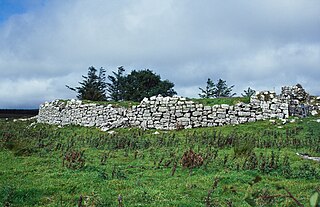Related Research Articles

Thomond, also known as the Kingdom of Limerick, was a kingdom of Gaelic Ireland, associated geographically with present-day County Clare and County Limerick, as well as parts of County Tipperary around Nenagh and its hinterland. The kingdom represented the core homeland of the Dál gCais people, although there were other Gaels in the area such as the Éile and Eóganachta, and even the Norse of Limerick. It existed from the collapse of the Kingdom of Munster in the 12th century as competition between the Ó Briain and the Mac Cárthaigh led to the schism between Thomond and Desmond. It continued to exist outside of the Anglo-Norman-controlled Lordship of Ireland until the 16th century.
McMahon, also spelt MacMahon, were different Middle Age era Irish clans. Their name is derived from the Gaelic MacMathghamhna meaning 'son of the bear'. According to historian C. Thomas Cairney, the MacMahons were one of the chiefly families of the Dal gCais or Dalcassians who were a tribe of the Erainn who were the second wave of Celts to settle in Ireland between about 500 and 100 BC.

The Dalcassians are a Gaelic Irish clan, generally accepted by contemporary scholarship as being a branch of the Déisi Muman, that became very powerful in Ireland during the 10th century. Their genealogies claimed descent from Tál Cas. Their known ancestors are the subject of The Expulsion of the Déisi tale and one branch of their blood-line went on to rule the petty kingdom of Dyfed in Wales during the 4th century; probably in alliance with the Roman Emperor Magnus Maximus.
Deer Island or Inishmore is located in County Clare, Ireland.

The O'Davoren family were a scholarly clan of Corcomroe, Thomond, Ireland active since medieval times.
Gilla na Naomh Ua hEidhin was King of Uí Fiachrach Aidhne until his death in 1100.
Mael Ruanaidh na Paidre Ua hEidhin was King of Ui Fiachrach Aidhne.
Gilla Ceallaigh Ua Cleirigh was King of Ui Fiachrach Aidhne.
Seán Buí Mac Bruideadha, Irish poet, fl. 14th century.
Concubhair Mac Bruideadha was an Irish poet and a man of letters.
Ó Caiside is the name of a Gaelic-Irish family. It is now usually anglicised as Cassidy.
Aodh Buí Mac Cruitín (1680–1755) was an Irish poet, tutor, and soldier.
Aindrias Mac Cruitín was a Gaelic-Irish poet.

The O'Brien dynasty was an Irish Clan and noble house of Munster, founded in the 10th century by Brian Boru of the Dál gCais (Dalcassians). After becoming King of Munster, through conquest he established himself as Ard Rí na hÉireann. Brian's descendants thus carried the name Ó Briain, continuing to rule the Kingdom of Munster until the 12th century where their territory had shrunk to the Kingdom of Thomond which they would hold for just under five centuries.

Conor na Siudane Ua Briain also by the descriptives "Roe" and also as "broad-eyed" was a King of Thomond, in medieval Ireland. He was the son of Donnchadh Cairbreach Ó Briain.

Toirdhealbhach Mór Ó Briain was King of Thomond (1276-1306) and the main protagonist of Seán mac Ruaidhri Mac Craith's epic Cathreim Thoirdhealbhaigh describing his struggles against the Norman Thomas de Clare.
Muircheartach Ó Briain was King of Thomond from 1317 until his death in 1343.

Donnchadh Cairbreach Ó Briain was King of Thomond from 1198 to his death in 1242. He founded Moor Abbey, early in the 13th century before it was re-founded in 1471 and established by the first Franciscan pontiff under the reign of Sixtus IV, a religious order founded by Saint Francis of Assisi.
Toirdhealbhach Bóg Ó Briain was King of Thomond from 1446 to his death in 1459.

Sir Donough O'Brien (1595-1634) was an Irish nobleman of the O'Brien family of Leameneagh.
References
- ↑ The Normans in Thomond, Joe Power, http://www.clarelibrary.ie/eolas/coclare/history/norman.htm
- ↑ The History and Topography of the County of Clare by James Frost, http://www.clarelibrary.ie/eolas/coclare/history/frost/chap12_conor_na_suidaine_obrien.htm
- ↑ John O'Hart,"Irish Pedigrees or the Origin and Stem of the Irish Nation", Volume 1, 1892, page 159, https://archive.org/stream/irishpedigreesor_01ohar#page/159